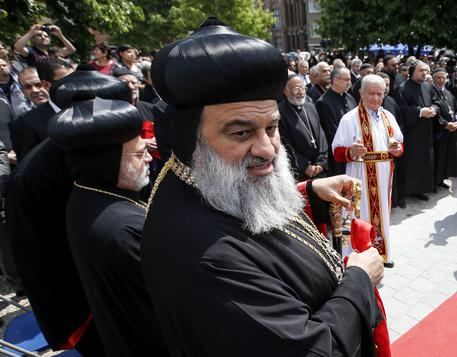
Christians in Syria, history and traditions
To speak of the Christian Churches in Syria is to sketch a living tradition that has its roots in the first generation of Christianity; over the centuries this tradition has been articulated into different denominations that have been able to find a modus vivendi that has allowed them to live their faith experience in confrontation with the political authorities that have governed Syria, defining a doctrine and a rite; these Churches have always cultivated their roots by claiming their evangelical origin, declined, even in the first centuries, in very different forms in an attempt to capture the cultural riches of the land where the Christians found themselves living. Alongside the churches that drew directly from the origins of Christianity, which represent one of the many spiritual peculiarities of the Middle East, others were formed in Syria, as in other countries in the region, at different times; these more recent communities reflected the multiplicity of Christian traditions by opening a window of the world in Syria. In the last decades of the 20th century, especially since the celebration of the Second Vatican Council, an ecumenical dialogue has been developing in Syria as well, helping to understand the common heritage of Christians who have been caught up in the civil war that has been bloodying Syria for more than a decade.
Precisely because of its history in Syria, therefore, a plurality of Christian Churches are present: along with the Roman Catholic Church which is present with communities of the Latin Church (Apostolic Vicariate of Aleppo), Armenian Catholic Church (Archieparchy of Aleppo, Eparchy of Kamichlié e Patriarchal Exarchate of Damascus), Maronite Church (Archieparchy of Damascus, Archieparchy of Aleppo, Eparchy of Laodicea), of the Chaldean Catholic Church (Eparchy of Aleppo), of the Greek-Melkite Catholic Church (Patriarchate of Antioch, Archieparchy of Aleppo, Archieparchy of Bosra and Hauran, Archieparchy of Damascus, Archieparchy of Homs e Archieparchy of Laodicea) and the Syrian Catholic Church (Archieparchy of Damascus, Archieparchy of Aleppo, Archieparchy of Hassaké-Nisibi e Archieparchy of Homs), the Armenian Apostolic Church, the Episcopalian Church, the Greek Orthodox Patriarchate of Antioch and All the East, the National Evangelical Synod of Syria and Lebanon, the Syrian Orthodox Patriarchate of Antioch and All the East of the Syriac Orthodox Church and the Union of Armenian Evangelical Churches in the Near East are present.
Of this plurality of Christian Churches, the Syriac Orthodox Church, as it has decided to call itself since 2000, choosing a name that would recover its history, represents one of the Christian traditions rooted in the first apostolic generation, with a strong missionary vocation to the end of the world, so much so that its liturgical language is Syriac which is close to Aramaic the language spoken by Jesus and his first disciples. Syriac missionaries headed mainly toward the East so much so that the creation of a Catholicate called to coordinate and guide the communities born as a result of this missionary action destined to reach India and China, after an initial season of preaching that had involved the entire Middle East, from Egypt to Iraq, dates back to the fourth century. Immersed in the politico-military events that shook the region for centuries of clashes between the Roman Empire and the Sassanid Empire, she took part in the theological debate of the early centuries, in the season of the first Ecumenical Councils, which led to a series of dogmatic definitions that led to the first divisions in the Church. Precisely as a result of the decisions taken by the Council of Chalcedon (451), an autonomous Church was created, the Syriac Orthodox Church, which gathered the faithful who did not believe in a Christ who was only apparently a man, whose nature is totally divine, who were called Monophysites. This was not an easy transition, so much so that it was not until the 6th century, mainly through the work of James Baradeus, that the Church took on a dimension that enabled it not only to survive the first Arab invasion, but to further grow its presence in the East, with thousands of parishes and monasteries. The appearance of the Mongols in the world scene led to a drastic reduction of the Syrian Orthodox Church, which managed to maintain its spiritual vitality that allowed it to endure even the new measures introduced by the Ottoman Empire and the internal discussions that lead some communities to reach an agreement with the See of Rome with the creation of a Church that, maintaining its own rite, joined the Catholic Church, while the difficulties in keeping alive the communion with the communities distributed in Asia, particularly those in India, were exacerbated.
The 20th century, especially in the first decades, was to be marked by new persecutions that caused death and destruction, prompting many of the faithful of the Syrian Orthodox Church to seek outside the traditional boundaries for a chance at life; after this season, which was so dramatic, the Church was able to find its own stability that was swept away by the civil war, paying a very high price in terms of human lives and destruction of places of worship and memories of the past.
The Syriac Orthodox Church, which has faithful scattered in so many countries, as a direct consequence of the diaspora with which it has been invested, is led by a patriarch, who has his seat in Damascus, elected by the Synod of bishops, who can only come from the monks; precisely monasticism still represents a central element in the life of the Church in deep continuity with its history. Since March 31, 2014, Moran Mar Ignatius Afram II has led the Syriac Orthodox Church and he is credited with many peace-building initiatives, including with a renewed commitment in the ecumenical field, in the belief that Christians together can sustain reconciliation processes in justice.
Riccardo Burigana
